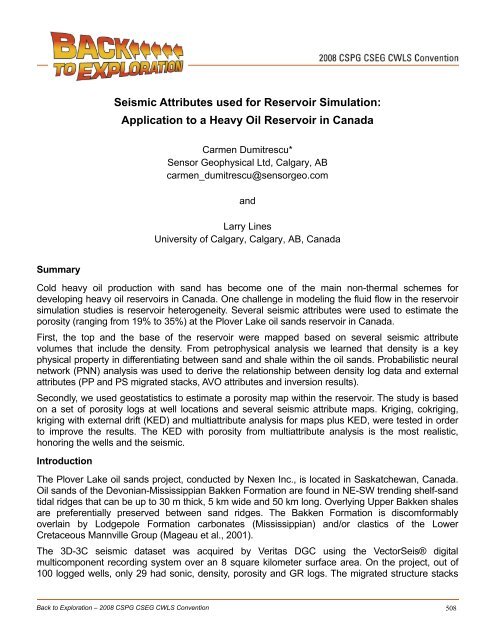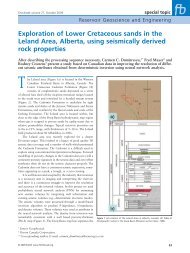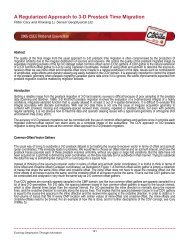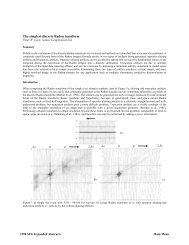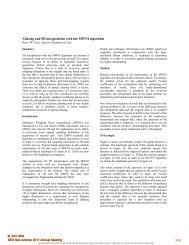Seismic Attributes used for Reservoir Simulation: Application to a ...
Seismic Attributes used for Reservoir Simulation: Application to a ...
Seismic Attributes used for Reservoir Simulation: Application to a ...
You also want an ePaper? Increase the reach of your titles
YUMPU automatically turns print PDFs into web optimized ePapers that Google loves.
<strong>Seismic</strong> <strong>Attributes</strong> <strong>used</strong> <strong>for</strong> <strong>Reservoir</strong> <strong>Simulation</strong>:<strong>Application</strong> <strong>to</strong> a Heavy Oil <strong>Reservoir</strong> in CanadaCarmen Dumitrescu*Sensor Geophysical Ltd, Calgary, ABcarmen_dumitrescu@sensorgeo.comandLarry LinesUniversity of Calgary, Calgary, AB, CanadaSummaryCold heavy oil production with sand has become one of the main non-thermal schemes <strong>for</strong>developing heavy oil reservoirs in Canada. One challenge in modeling the fluid flow in the reservoirsimulation studies is reservoir heterogeneity. Several seismic attributes were <strong>used</strong> <strong>to</strong> estimate theporosity (ranging from 19% <strong>to</strong> 35%) at the Plover Lake oil sands reservoir in Canada.First, the <strong>to</strong>p and the base of the reservoir were mapped based on several seismic attributevolumes that include the density. From petrophysical analysis we learned that density is a keyphysical property in differentiating between sand and shale within the oil sands. Probabilistic neuralnetwork (PNN) analysis was <strong>used</strong> <strong>to</strong> derive the relationship between density log data and externalattributes (PP and PS migrated stacks, AVO attributes and inversion results).Secondly, we <strong>used</strong> geostatistics <strong>to</strong> estimate a porosity map within the reservoir. The study is basedon a set of porosity logs at well locations and several seismic attribute maps. Kriging, cokriging,kriging with external drift (KED) and multiattribute analysis <strong>for</strong> maps plus KED, were tested in order<strong>to</strong> improve the results. The KED with porosity from multiattribute analysis is the most realistic,honoring the wells and the seismic.IntroductionThe Plover Lake oil sands project, conducted by Nexen Inc., is located in Saskatchewan, Canada.Oil sands of the Devonian-Mississippian Bakken Formation are found in NE-SW trending shelf-sandtidal ridges that can be up <strong>to</strong> 30 m thick, 5 km wide and 50 km long. Overlying Upper Bakken shalesare preferentially preserved between sand ridges. The Bakken Formation is discom<strong>for</strong>mablyoverlain by Lodgepole Formation carbonates (Mississippian) and/or clastics of the LowerCretaceous Mannville Group (Mageau et al., 2001).The 3D-3C seismic dataset was acquired by Veritas DGC using the Vec<strong>to</strong>rSeis® digitalmulticomponent recording system over an 8 square kilometer surface area. On the project, out of100 logged wells, only 29 had sonic, density, porosity and GR logs. The migrated structure stacksBack <strong>to</strong> Exploration – 2008 CSPG CSEG CWLS Convention 508
<strong>for</strong> the PP (vertical) and <strong>for</strong> the PS (radial) component were produced by Sensor Geophysical Ltd.as part of a CHORUS (Consortium <strong>for</strong> Heavy Oil Research by University Scientists) project at theUniversity of Calgary.To achieve an optimal estimation of density, pre- and post-stack seismic attributes (PP and PSstacks, AVO attributes and inversion results) were <strong>used</strong> in the probabilistic neural network (PNN)analysis. The estimated density volume was <strong>used</strong> <strong>for</strong> mapping the <strong>to</strong>p (Upper/Mid Bakken) and thebase (Lower Bakken) of the heavy oil reservoir at Plover Lake.Figure 1: Map showing the Plover Lake area, Saskatchewan, Canada.Once we had the <strong>to</strong>p and the base of the reservoir, we mapped porosity within the reservoir usingseveral geostatistical methods such as kriging, cokriging, kriging with external drift (KED) andmultiattribute analysis that were compared in terms of accuracy. The estimated porosity map will be<strong>used</strong> in a subsequent ef<strong>for</strong>t, <strong>for</strong> reservoir simulation at Plover Lake.MethodPart A: Mapping the <strong>to</strong>p and the base of the reservoirFrom petrophysical analysis, we learned that density is a key physical property in differentiatingbetween sand and shale within the oil sands. There<strong>for</strong>e, having a density volume available over theBakken Formation would be very useful <strong>for</strong> mapping the <strong>to</strong>p and the base of the reservoir. PNNanalysis was <strong>used</strong> <strong>to</strong> derive the relationship between attributes of the seismic data and density logdata. The PNN analysis <strong>used</strong> as input the PP and PS stacks, the AVO attributes and the inversionresults, discussed in previous papers by Dumitrescu et al. (2006 and 2007).PNN analysis, has four steps: (i) per<strong>for</strong>m a multiattribute step-wise linear regression and itsvalidation, (ii) train neural networks <strong>to</strong> establish the nonlinear relationships between seismicattributes and reservoir properties at well locations, (iii) apply trained neural networks <strong>to</strong> the 3-Dseismic data volume, (iv) validate results on wells withheld from training.Part B: Mapping PorosityThe advantage of using geostatistics is that we can both honor the primary data values at the welllocations as well as honor the “spirit” of the dense dataset away from the wells. In this project, wetested three different ways of bringing in a secondary dataset: (i) cokriging, (ii) KED, and (iii)multiattribute analysis <strong>for</strong> maps plus KED. The multiattribute analysis involves combining multiplemap attributes <strong>to</strong> predict a reservoir parameter such as porosity, by training at the well locations.Back <strong>to</strong> Exploration – 2008 CSPG CSEG CWLS Convention 509
This method is an extension of the multiattribute approach applied <strong>to</strong> seismic volumes (Hampson etal., 2001).ResultsPart A: Mapping the <strong>to</strong>p and the base of the reservoirNeural network analysis <strong>used</strong> as a target log the density from 22 wells and as external attributesseven seismic volumes: P-wave reflectivity, S-wave reflectivity, the Fluid Fac<strong>to</strong>r, the PP and PSstacks, P-wave impedance and S-wave impedance.Figure 2 (left) presents a cross-plot of Density and Gamma Ray logs (colored by porosity) withzones defining sand and shale within the reservoir and at all 22 wells. The same zones areidentified on the cross-plot of the actual and predicted density logs (Figure 2, right).Gamma Ray(api)200Porosity (%)35Predicted density(kg/m 3 )2650Cross-correlation=96%shaleshalesandsand02000 Density (kg/m 3 )2650192000 Actual density (kg/m 3 )2650Figure 2: (left) Cross-plot of the Gamma Ray and Density logs (colored by porosity) and (right)Cross-plot of the actual density and predicted density logs using PNN. A perfect predictioncorresponds <strong>to</strong> the red diagonal line. Data points from the analysis zone of all 22 wells.The cross-correlation between actual and predicted logs is 94% showing a good prediction of thedensity log in the Bakken reservoir at Plover Lake.Some observations about this reservoir are: (i) from petrophysical analysis we know that density is akey physical property; (ii) the <strong>to</strong>p of the reservoir is Upper Bakken that is almost identical with MidBakken in many wells, (iii) the base of the reservoir is Lower Bakken, (iv) synthetics <strong>for</strong> several wellsdisplay the Upper/Mid Bakken as a trough and Lower Bakken as a peak, both very difficult <strong>to</strong>identify on the migrated stack (Figure 3a), and (v) a density volume proves <strong>to</strong> be quite useful inmapping the <strong>to</strong>p and the base of the reservoir (Figure 3b).Back <strong>to</strong> Exploration – 2008 CSPG CSEG CWLS Convention 510
WMBLBaDensity (kg/m 3 )2650TW2100bMBLBTFigure 3: (a) Rp and inserted synthetic traces <strong>for</strong> several wells and (b) density results on EWline 37 of the 3D. Inserted in color are the density logs. All the wells tie this line within a 60 mprojection distance. (W: Waseca, MB: Mid Bakken, LB: Lower Bakken, T: Torquay).Part B: Mapping PorosityIn this paper, we integrated the wireline logs and seismic data <strong>to</strong> directly predict porosity map withinthe heavy oil reservoir. First, we produced porosity maps using kriging (based only on wellsin<strong>for</strong>mation), cokriging (based on wells as primary variable and P-impedance slice as the secondaryvariable) (Figure 4) and KED (Figure 5a). Next, we improved the initial fit using multiple attributes.The multiattribute analysis result has produced a good prediction of porosity. However, it does nottie all the wells. Finally, we <strong>used</strong> the multiattribute analysis derived porosity map as a secondaryvariable <strong>for</strong> KED (Figure 5b).Porosity (%)35ab19Figure 4: Porosity maps based on: (a) kriging and (b) cokriging method.Back <strong>to</strong> Exploration – 2008 CSPG CSEG CWLS Convention 511


